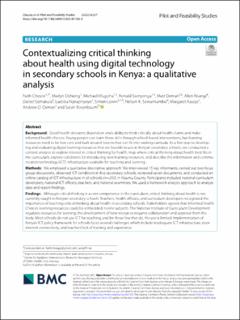| dc.description.abstract | Background Good health decisions depend on one’s ability to think critically about health claims and make informed health choices. Young people can learn these skills through school-based interventions, but learning resources need to be low-cost and built around lessons that can fit into existing curricula. As a first step to developing and evaluating digital learning resources that are feasible to use in Kenyan secondary schools, we conducted a context analysis to explore interest in critical thinking for health, map where critical thinking about health best fits in the curriculum, explore conditions for introducing new learning resources, and describe the information and communication technology (ICT) infrastructure available for teaching and learning. Methods We employed a qualitative descriptive approach. We interviewed 15 key informants, carried out two focus group discussions, observed ICT conditions in five secondary schools, reviewed seven documents, and conducted an online catalog of ICT infrastructure in all schools (n=250) in Kisumu County. Participants included national curriculum developers, national ICT officers, teachers, and national examiners. We used a framework analysis approach to analyze data and report findings. Findings Although critical thinking is a core competence in the curriculum, critical thinking about health is not currently taught in Kenyan secondary schools. Teachers, health officials, and curriculum developers recognized the importance of teaching critical thinking about health in secondary schools. Stakeholders agreed that Informed Health Choices learning resources could be embedded in nine subjects. The National Institute of Curriculum Development regulates resources for learning; the development of new resources requires collaboration and approval from this body. Most schools do not use ICT for teaching, and for those few that do, the use is limited. Implementation of Kenya’s ICT policy framework for schools faces several challenges which include inadequate ICT infrastructure, poor internet connectivity, and teachers’ lack of training and experience. Conclusion Teaching critical thinking about health is possible within the current Kenyan lower secondary school curriculum, but the learning resources will need to be designed for inclusion in and across existing subjects. The National ICT Plan and Vision for 2030 provides an opportunity for scale-up and integration of technology in teaching and learning environments, which can enable future use of digital resources in schools. However, given the current ICT condition in schools in the country, digital learning resources should be designed to function with limited ICT infrastructure, unstable Internet access, and for use by teachers with low levels of experience using digital technology. | en_US |

